/*
Please refer to readme.html for full Instructions
Text[...]=[title,text]g
Style[...]=[TitleColor,TextColor,TitleBgColor,TextBgColor,TitleBgImag,TextBgImag,TitleTextAlign,TextTextAlign, TitleFontFace, TextFontFace, TipPosition, StickyStyle, TitleFontSize, TextFontSize, Width, Height, BorderSize, PadTextArea, CoordinateX , CoordinateY, TransitionNumber, TransitionDuration, TransparencyLevel ,ShadowType, ShadowColor]
*/
var FiltersEnabled = 0
Style[6]=["#FFFFFF","#000000","#4B4C57","#FFFFFF","","","","","","","","","2","","250","",2,2,10,10,"","","","",""]
Style[5]=["#FFFFFF","#000000","#4B4C57","#E8E8E8","","","","","","","","sticky","","",180,"",2,2,10,10,"","","","",""]
Style[4]=["#FFFFFF","#000000","#4B4C57","#FFFFFF","","","","","","","","sticky","2","",180,"",2,2,10,10,"","","","",""]
Style[3]=["#FFFFFF","#000000","#4B4C57","#FFFFFF","","","","","","","","","2","2","300","",2,2,10,10,"","","","",""]
Style[2]=["#FFFFFF","#000000","#4B4C57","#FFFFFF","","","","","","","","","2","1","200","",2,2,10,10,"","","","",""]
Text[1]=["Butrinti (anc. Buthrote)","One of the major sites of Albania, classified in the world heritage of UNESCO. The ruins show a beautiful urban whole : theatre, thermal baths….
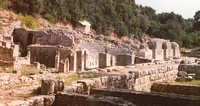
Photo Galen R. Frysinger"]
Text[2]=["Durrës (anc. Dyrrachium)","The amphitheatre was discovered only in 1966. Built in the 1st century of our era, one among of most beautiful of the balkans."]
Text[3]=["Evora","Temple of Diana."]
Text[4]=["Vidigueira"," Roman road bridge."]
Text[5]=["Volubilis","Most spectacular mosaics decorating the ground of the villas: house with the Venus Procession, house of the Deer, house of Hercules’ works, house with the Columns, house of Orpheo.Four roman baths (thermal baths of he North, of Gallien…). Arch of Caracalla, gate of Tangier and decumanus maximus, the forum and its steles, beautiful basilica, the capitole and its sacred area. Oil mills and bakeries have been identified. Site classified by UNESCO.

Photo Galen R. Frysinger"]
Text[6]=["Santiponce (Italica) ","Amphitheatre, Roman theatre, temple of Trajan. Thermal baths and houses (mosaic). "]
Text[7]=["Chaves","Road bridge of 2nd century on the Ribeira de Cavez, 12 arches."]
Text[8]=["Mérida (anc. Emerita Augusta)","The most important Roman site in Spain: very well preserved 6000 seats theatre, amphitheatre, circus, temple of Diana, arch of Trajan, Roman bridge, aqueduct (bridge of the Miracles), houses and mosaics…"]
Text[9]=["Carmona","Amphitheatre, necropolis of 1st century B.C., Gate of Seville."]
Text[10]=["Marbella","Thermal baths of Guadalmina, Roman villa of Río Verde, bridge nearby."]
Text[11]=["Cordoba","Bridge of 16 spans on the Guadalquivir, 1st century B.C."]
Text[12]=["Salamanque (anc. Salmantica)","The 26 arches bridge on the Tormes, probably from the 1st century "]
Text[13]=["Medellín","The superb Roman bridge on the Guadiana. Ruins of a theatre."]
Text[14]=["Málaga (anc. Flavia Malacita )","The theatre, built with the time of Augustus."]
Text[15]=["Segovia (anc. Segubia)"," A prestigious remarkably preserved aqueduct, classified on the list of UNESCO, 900 meters long and 28 meters high (1st century). "]
Text[16]=["Segobriga","Theatre, thermal baths, vestiges of en amphitheatre (2nd century)."]
Text[17]=["Cartagena ","Theatre (6000 seats), extremely well preserved."]
Text[18]=["Albarracin","Underground aqueduct which connected Albarracín to Cella."]
Text[19]=["Chelva","Aqueduct Pena Cortade between Calles and Chelva (well preserved, two high arches). "]
Text[20]=["Sagunto (anc. Saguntum)","Theatre of 1st century, recently restored… and modernized…"]
Text[21]=["Tarragone (anc. Tarraco)","Beautiful aqueduct, Scipions’ tower, vestiges of the amphitheatre and of the city walls, mosaics."]
Text[22]=["Cherchell (anc. Caesarea) ","Two museums are dedicated to the Roman city’s ruins (amphitheatre, roman statues, mosaics, monuments…). "]
Text[23]=["Saintes (anc. Mediolanum Santonum)","Arch of of Germanicus. Ruins of an amphitheatre and an aqueduct."]
Text[24]=["Tipaza (anc. Tipasa)","Imposing amphitheatre. Vestiges of a basilica, forum, nymphee, thermal baths. Towards the West, the Caeserea gate and the theatre (scene, external vaults and some steps)."]
Text[25]=["Chassenon (anc. Cassinomagus)","Gallo-Roman thermal baths among the best preserved in Europe, ruins of a theatre."]
Text[26]=["Empuries (anc. Emporiae)","Ruins of the Roman city: forum, public baths, large private houses decorated with mosaics, streets, amphitheatre and palestra."]
Text[27]=["Narbonne (anc. Narbo Martius) ","Underground galleries of Horreum, 1st century B.C., unique in Europe. The site of the Clos de la Lombarde and vestiges of aqueducts nearby."]
Text[29]=["Villetelle (anc. Ambrussum)","Foundations of many buildings, of fortifications, of a bridge. Very visible, the Via Domitia."]
Text[30]=["Djemila (anc. Cuicul)","Cuicul, with its forum, its temples and its basilicas, its triumphal arches and its houses, at 900 m heigth, is a remarkable example of Roman town planning adapted to a mountainous site. Thermal baths of Commode."]
Text[31]=["Lambese (anc. Lambaesis)","The amphitheatre, arches of Commode and Severe Septime, ruins of temples, baths, aqueduct. The praetorium (ca 268 B.C.), roman cemetery."]
Text[32]=["Nimes (anc. Nemausus)","An exceptional inheritance of 1st century: Roman well preserved amphitheatre (arenas), Maison Carrée (temple dedicated to Caius and Lucius Caesar, the only entirely preserved temple of the ancient world, the Magne Tower, the highest of the city walls from Augustus, the Temple of Diana, Castellum divisorium, water supply basin, Augustus’ gate, France’s gate…"]
Text[33]=["Timgad (anc. Thamugadi)","One of the major sites of North Africa. A whole, well preserved city, with its forum, theatre, library. The capitole of Timgad, Sertius and Faustus house, temples of Dea Patria and Aqua septimiana Felix, large baths and many local baths, the arch known as of Trajan’s, the necropolis. Many mosaïcs."]
Text[34]=["Arles (anc. Arelate)","Listed on the world heritage of UNESCO: the roman amphitheatre (arena), the theatre, Cryptoportiques, Constantin’s roman baths, ruins of the circus, aqueducts of Caparon, of Eygalieres, of Barbegal.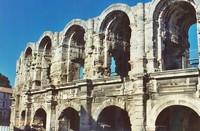
Photo Galen R. Frysinger"]
Text[35]=["Pont du Gard à Remoulins ","This famous Roman aqueduct has three levels of arches (classified UNESCO). It led water from the Eure sources to water tanks (Castellum) of Nimes. 275m long, 49m high, it crosses the Gardon near Remoulins.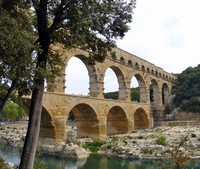
Photo Galen R. Frysinger"]
Text[36]=["Saint-Remy-de-Provence (anc. Glanum)","A famous place of roman history in France. A whole a greco-roman city, its arch of triumph, an intact cenotaph…
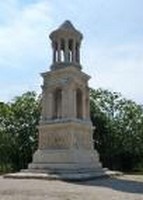
Photo Galen R. Frysinger"]
Text[37]=["Annaba (anc. Hippone ou Hippo Regius)","The ruins of Hippone: the residential quarter where most of the mosaics were found, the large thermal baths and the forum, the fountain of Gorgona, the theatre). "]
Text[39]=["Autun (anc. Augustodunum)","City walls with the gates of Saint-Andrew and of Arroux, the theatre, the temple of Janus, ruins of the Cardo and the pyramid of Couhard. Aqueduct of Montjeu and Mondru."]
Text[41]=["Orange (anc. Arausi)","Two monuments registered by UNESCO: the best preserved theatre of Europe, with its stage wall, and the monumental arch with three gates."]
Text[42]=["Lyon (anc. Lugdunum)","Theatres of Fourviere, the odeon, roman baths, the fountain of Trion, mausoleums nearby, aqueducts provided with siphons"]
Text[43]=["Vienne (anc. Vienna)","At St-Romain-de-Gall, many mosaics and Gallo-Roman vestiges among which the baths of the Fighters. In Vienne, ancient theatre and temple of Augustus and Livia, 1st century."]
Text[44]=["Grand (anc. Granum, Andesina)","Gallo-Roman amphitheatre from the 1st century, 17000 seats, a 224 m2 large mosaic, ruins of city walls. Aqueducts nearby."]
Text[45]=["Tébessa (anc. Thevestis)","Amphitheatre, temple of Minerva, arch of Caracalla, aqueduct, monuments…"]
Text[46]=["Vaison-la-Romaine (anc. Vasio) ","Gallo-Roman ruins : sites of Puymin and Villasse, in the city. Bridge over the Ouveze, 17m long. Theatre (much restored), rare vestiges of the aqueduct of Groseau..."]
Text[47]=["Fréjus (anc. Forum Julii, Colonia Octavianorum)","A rich whole : amphitheatre, aqueduct, theatre, city walls, ruins of roman baths, etc."]
Text[48]=["Besançon (anc. Vesontio)","The Black gate (vestige of a triumphal arch built under Marc Aurele), some ruins of the arenas of Vesontio, an aqueduct and columns in the Castan public garden"]
Text[49]=["Nice-Cimiez (Cemenelum) ","Arenas of Cimiez, roman baths, vestiges of an aqueduct (Mouraille)."]
Text[50]=["Avenches (anc. Aventicum)","City wall and amphitheatre; vestiges of the temple of the Grange-aux-dimes ; the theatre, the roman baths of the forum."]
Text[52]=["Aoste (anc. Augusta Praetoria)","Praetorian door, arch of Augustus, remainders of an amphitheatre and forum. Roman bridges nearby (Pondel, Saint-Martin…)"]
Text[53]=["Mandeure (anc. Epomanduodurum)","Some vestiges of a large theatre (142m of frontage) from 1st-2nd century, as well as roman baths of Courcelles"]
Text[54]=["Sbeïtla (anc. Sufetula)","A remarkably preserved whole. The capitole formed of three temples, the Roman paved forum, the archs of Antonin and Diocletian. Aqueduct, of large public baths, theatre.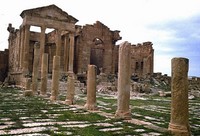
Photo Galen R. Frysinger"]
Text[55]=["la Turbie","The trophy of Augustus at the highest point of the old via Julia Augusta, dominates the french reviera. One of the rare buildings of this type still preserved. Vestiges of aqueducts."]
Text[56]=["Martigny (anc. Forum Claudii Vallensium, Octodurum)","Ruins of the amphitheatre, Mithraeum, Domus of the domestic Genius and of Temenos."]
Text[57]=["Augst (anc. Augusta Raurica)","The theatre, ruins of the amphitheatre and temple, a forum and roman baths, different buildings.."]
Text[58]=["Dougga (anc. Thucca) ","The Roman best preserved small town of North Africa, according to the list of UNESCO. The theatre (2nd century) leaned against the hill. Close to the forum, the place of the Compass card and the Capitole. Temples of Junon Caelestis, Mercury, Saturn, the Arch of Severe Alexandre, the Licinian baths, the baths of the Cyclops, etc."]
Text[59]=["Carthage (anc. Colonia Julia Carthago)","Few remains of the Roman times. The much restored theatre (2nd century), ruins of the Antoninian baths and of the amphitheatre.
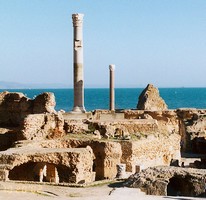
Photo Galen R. Frysinger"]
Text[60]=["Oudhna (anc. Utina) ","A city of the 2nd century. a very beautiful amphitheatre, a capitole, baths, cisterns, an aqueduct and rich villas."]
Text[63]=["El Jem (anc. Thysdrus)","The imposing amphitheatre with 30000 seat, superbly preserved.
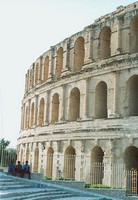
Photo Galen R. Frysinger"]
Text[65]=["Luni (anc. Luna)","Vestiges of an amphitheatre and a temple."]
Text[66]=["Rusellae ","Vestiges of an amphitheatre and roman houses."]
Text[67]=["Sabratha","Superb theatre (larges parts of the stage wall are preserved), basilica of Apulea, basilica of Justinian (mosaics). Temples of Antonians, of Liber Pater, of Serapis and Isis; Capitole and baths known as of the Sea.
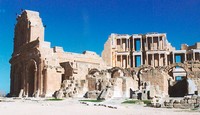
Photo Galen R. Frysinger"]
Text[68]=["Fiesole","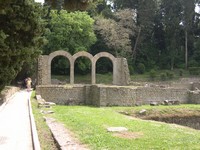
Etrusco-Roman archaeological site: theatre, ruins of the baths…"]
Text[69]=["Verona","The richest Roman inheritance in northern Italy. Amphitheatre (arena), stone bridge across the Adige (rebuilt after 1945), arch of Gavi, Carries Borsari. Theatre from the 1st century. Ruins of Gallians city walls."]
Text[70]=["Blera","Bridges (Ponte del Diavolo, Ponte della Rocca)."]
Text[71]=["Rimini (anc.Ariminum) ","Arch of Augustus, bridge of Tibere, ruins of Hadrian’s amphitheatre."]
Text[72]=["Ostie (Ostia antica)","A major site: theatre, paved streets, the house of Auriges, house of Diana, mosaics of the baths of Neptune, etc."]
Text[73]=["Fano (anc. Fanum Fortunae) ","Arch of Augustus, built in 9 A.D., city walls."]
Text[74]=["Carsulae ","Some remains of the city, on Via Flaminia: Chiesa di San Damiano, paleo-Christian church built on Roman foundations, the basilica, the baths, the cistern, two temples, the forum, Flavian’s amphitheatre, an older theatre (Augustus), the arch of Trajan and various funerary monuments."]
Text[75]=["Rome (Roma)","It’s useless trying to list, and we give up !! 10 pages would not be enough, and monuments stay at every street corner… Please refer to your traveller guide!"]
Text[76]=["Pouzzole (anc. Puteoli)","An old food market (macellum), known as Temple of Serapis, and the large Flavian amphitheatre, built under Vespasian (69 to 79 A.D.)."]
Text[77]=["Ancona","Trajan’s arch, 18m high, built ca 114-115 at the entrance of the harbour. Ruins of the amphitheatre (no visits)."]
Text[78]=["Spello (anc. Hispellum)","The perfectly preserved Venere Gate, from Augustus, and the Arch of Augustus."]
Text[79]=["Minturno (anc. Minturnae) ","Beautiful archeological site, paved roads, theatre, beautiful aqueduct."]
Text[80]=["Ascoli Piceno","Roman bridges of Solestà, Ponte Mallio…"]
Text[81]=["Tivoli ","The immense Villa Adriana built between 118 and 134 for the emperor Hadrian, with its many constructions (baths, library, maritime theatre…). See also the sanctuary of Hercules and the Temple of Sybille. Ruins of the amphitheatre from Bleso. "]
Text[82]=["Triest (anc. Tergeste) ","Ruins of the Roman theatre (1st-2nd century)"]
Text[83]=["Naples (anc. Neapolis)","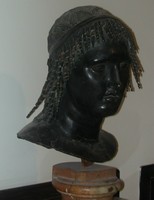
Let us note Naples for its unique archaeological museum which displays the finds of Pompei, Herculanum, etc."]
Text[84]=["Piazza Armerina","The fantastic Roman villa Casale constructed by the end of 3rd century. Roman baths, about thirty rooms decorated with exceptionnal mosaics covering 3500 m2.
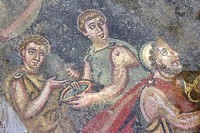
Photo Galen R. Frysinger"]
Text[86]=["Pula","Very beautiful amphitheatre built under the ruling of Augustus, enlarged by Vespasien in 79 A.D. (24000 seats). The three levels of arches are preserved.
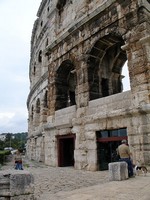
Photo Galen R. Frysinger"]
Text[87]=["Santa Maria Capua Vetere (anc. Capua)","The amphitheatre of Capua built under Augustus and modified by Hadrian. Bridge on the Volturno, arch of Hadrian"]
Text[88]=["Oplontis","Buried like Pompei, Herculanum and Stabies after the eruption of the Vesuvius in 79. The superb Roman villa of Poppee (1st century B.C.), the villa of Crassus and its frescoes."]
Text[89]=["Herculanum","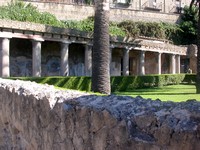
The city buried by the eruption of the Vesuvius in 79: even a simple enumeration is impossible, the visit is a must!"]
Text[90]=["Pompei","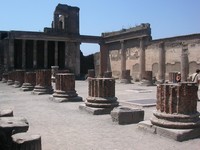
The archeological site of reference for Roman history : a whole city in a unique state of preservation…"]
Text[91]=["Catane","Ruins of the amphitheatre and the odeon (partially buried out), aqueduct, forum, baths."]
Text[92]=["Taormina (anc. Tauromenium)","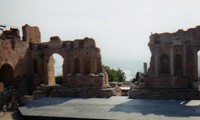
One of the most important ancient theatres, on a wonderful site. Ruins of the Odeon and the Naumachie (roman baths)."]
Text[93]=["Benevent (anc. Beneventum) ","Trajan’s triumphal arch built in 114, and the theatre of Hadrian, enlarged by Caracalla, are very well preserved. See also the ruins of Santi Quaranta, the Leproso Bridge, the statue of the Apis bull."]
Text[94]=["Syracuse","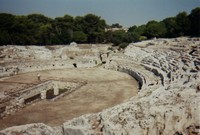
The roman amphitheatre, catacombs of San Giovanni."]
Text[95]=["Lucera (anc. Luceria)","The augustian amphitheatre, 1st century B.C."]
Text[97]=["Canosa di Puglia","Very beautiful road bridge over the Ofanto, on Via Appia Traiana. 5 arches."]
Text[98]=["Bad Deutsch-Altenburg (anc. Carnuntum)","Two amphitheatres, roman baths, the arch of the Heathers gate, the city."]
Text[100]=["Lecce (anc. Lupiae)","Amphitheatre, theatre (2nd century)."]
Text[101]=["Gamzigrad","Fortifications, Galere’s palace with a beautiful whole of columns and mosaics. Temples, baths, the basilica, a Tetrapylon."]
Text[102]=["Corinth (anc. Laus Iulia Corinthiensis)","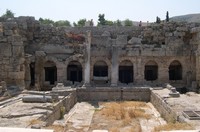
With exception of the temple d' Apollo, the Greek city was destroyed by the Romans in 146 B.C., who then rebuilt it on the next century. Thus the roman city is to visit, with its odeon, the ruins of Octavia’s temple, the fountains, the famous Lechaion street …"]
Text[103]=["Athens","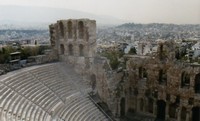
The greek capital, but the Roman remains are very numerous: forum, Hadrian’s library and arch, temple of Olympian Jupiter, theatre of Herode Atticus…"]
Text[104]=["Plovdiv (anc. Philippopolis puis Trimontium) ","Superb theatre built under Trajan, odeon, forum, stadium."]
Text[105]=["Gortyne","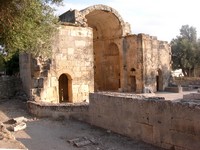
The capital of Roman Crete. The Odeon has been buried out, as was the Praetorian aera. Other ruins are disseminated in the surroundings."]
Text[106]=["Delos","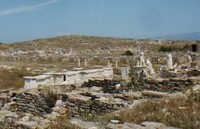
In 166 B.C., the Romans declare Delos as a free port. A great number of houses and ruins of greco-poman town (which will be then plundered in 88 by Mithridate) remain from this time."]
Text[108]=["Pergamon (anc. Pergamun) ","Pergame reaches its apogee at the 2nd century, with the construction of large buildings such as the Asclepeion and the theatre built on the slope of the acropolis. Ruins of Trajan’s and Telesphoros temple.
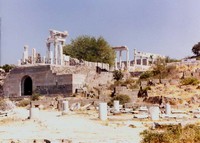
Photo Galen R. Frysinger"]
Text[109]=["Varna (anc. Odessos)","Ruins of the big roman baths (2nd century)."]
Text[110]=["Allianoi","A thermal complex of 9000 m2 in good state, from Hadrian’s time (117-138). Underpasses, sumptuous baths, mosaics… which could be well quickly lie under the waters of an irrigation dam, whereas hardly a quarter of the city was explored…"]
Text[111]=["Ephese (anc. Ephesos)","A site among the richest of the Roman world: the street of Couretes, Hadrian’s temple, the vestiges of Trajan’s fountain, the baths of scholastika, rich villas, the frontage of the library of Celsus, Mazeus and Mithridate’s gate. The Marble street and the theatre, the gymnasium, the odéon… Ruins of Varius’ baths, the academy, the monument of Caius Memmius, Domitian’s temple, etc. Several buildings of the early christian times.
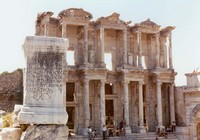
Photo Galen R. Frysinger"]
Text[112]=["Miletus","In the ruins of Milet, Greek, Roman and Moslem constructions are superimposed. The theatre, modified at the Roman time, could accept 15000 people. Roman baths of the 1st century, Vergilius Capito’s baths, Faustine’s baths (2nd century) nymphee, ruins of the trophy of Actium, etc."]
Text[113]=["Istanbul (anc. Constantinopolis)","Few traces remind the reign of Constantin, but from the Roman eastern empire, remain vestiges of the old hippodrome with Theodose’s obelisk, the serpentine column and Constantin’s column. Visit also the extraordinary cistern of Justinian. Valens’ aqueduct on two levels, from 368 A.D., is still visible. Lastly, the church Sainte-Irene built in 324 by Constantin and rebuilt by Justinian in the 6th century and the basilica of Sainte-Sophie (532 to 537), The city walls built by Theodose."]
Text[114]=["Aphrodisias ","An impressive site: the theatre built in 27 B.C. for 8000 spectators, its galleries, Hadrian’s baths and the odeon. The stadium (1st century) is among the best preserved (270x60m). The temple of Aphrodite and the tetrapylon at its entrance."]
Text[115]=["Pamukkale (anc. Hierapolis)","A thermal city created towards the end of the 2nd century B.C.. Domitian’s gate (triumphal arch with three arches), theatre with 15000 seats, several roman baths. Ruins of the Temple of Apollo and of Pluto’s sanctuary, nymphee, martyrium of Saint Philip (5th century)."]
Text[116]=["Phaeselis ","Theatre, beautiful aqueduct, vestiges of the baths. Beautiful paved road, traces of various constructions. "]
Text[118]=["Perge; ","Beautiful greco-roman theatre (15000 seats), ruins of the thermal baths and the stadium (2nd century). City wall, fountain dedicated to Severe Septime. The long street decorated with columns ends at a monumental fountain (nymphee). Two basilicas (5th and 6th centuries)."]
Text[119]=["Aspendos ","The theatre, built by Marc-Aurele, is exceptionally well preserved and practically intact with its stage-wall and its galleries. Nymphee, basilica, forum, streets. Traces of a stadium. Ruins of an aqueduct comprising a double siphon."]
Text [120] = [" Side " , " Roman theatre (1st- 2nd century, 15000 seats). "]
Text[121]=["Kato Paphos","Necropolis of the Tombs of the Kings, house of Dionysos, house of Thesee, house of Aion, Saint-Paul’s pillar.
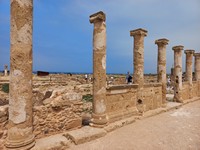
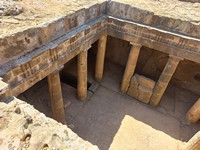 "]
Text[122]=["Kourion","Mosaics in the houses of Achilles, of the Gladiators, of Eustolios. The theatre, the baths. Stadium of the 2nd century AD. Sanctuary of Apollo.
"]
Text[122]=["Kourion","Mosaics in the houses of Achilles, of the Gladiators, of Eustolios. The theatre, the baths. Stadium of the 2nd century AD. Sanctuary of Apollo.
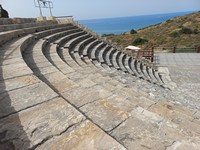 "]
Text[123]=["Adana ","The roman 310m long stone bridge which crosses the river Seyhan (anc. Sarus) at Adana, kept 14 of its 21 original arches. The date of construction remains uncertain… "]
Text[124]=["Cesarea (anc. Caesarea Maritima)","Herodian theatre, aqueduct (335 m), ruins of the baths and of habitations"]
Text [125] = [" Beit Guvrin (anc. Eleutheropolis) " , " Ruins of the amphitheatre"]
Text[126]=["Sour (anc. Tyr) ","Necropolis, aqueduct, monumental arch, roman road, hippodrome, ruins of the baths, amphitheatre.
"]
Text[123]=["Adana ","The roman 310m long stone bridge which crosses the river Seyhan (anc. Sarus) at Adana, kept 14 of its 21 original arches. The date of construction remains uncertain… "]
Text[124]=["Cesarea (anc. Caesarea Maritima)","Herodian theatre, aqueduct (335 m), ruins of the baths and of habitations"]
Text [125] = [" Beit Guvrin (anc. Eleutheropolis) " , " Ruins of the amphitheatre"]
Text[126]=["Sour (anc. Tyr) ","Necropolis, aqueduct, monumental arch, roman road, hippodrome, ruins of the baths, amphitheatre.
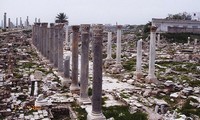
Photo Galen R. Frysinger"]
Text [127] = [" Jableh " , " The theatre counts 7000 seats."]
Text[128]=["Beit Shean (anc. Scythopolis)","Theatre, baths, colonnade of the Palladius street.
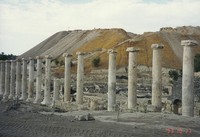
Photo Galen R. Frysinger"]
Text[129]=["Massada ","Ruins of the warehouses and the Herodian baths. The fortress of Massada. The slope built into 73 by the Romans to besiege it is still practicable. Traces of the roman camp."]
Text[130]=["Apamea ","Impressive, long double colonnade on the Cardo Maximus. Ruins of the baths."]
Text[131]=["Umm Qeis (anc. Gadara) ","Roman road with colonnade, ruins of two theatres and buildings. Nymphee, basilica, baths, temples."]
Text[132]=["Jerash (anc. Gerasa)","One of the most beautiful roman cities of the Middle East, 2nd century. The Hadrian’s arch, counting three gates. The forum with the well preserved colonnades, theatres, ruins of the temple of Zeus and Artemis. Nymphee, Tetrapylons ; the hippodrome, Cardo maximus and Decumanus, Macellum (market), baths, gates and Diocletian city walls from the 4th century.
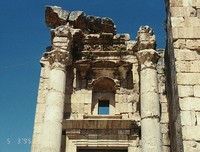
Photo Galen R. Frysinger"]
Text[133]=["Bosra ","Beautiful Roman theatre with its stage wall. Fortress, some streets kept their columns."]
Text[134]=["Amman (anc. Philadelphia)","Ruins of the theatre and the temple of Hercules."]
Text[135]=["Tabaqat Fahil (anc. Pella) ","After being liberated by Pumped in 63 B.C., the city became prosperous. However only ruins of a small theatre subsist, with roman baths and a temple of Serapis."]
Text[136]=["Zeugma","Unique mosaics rescued before the site was overflown under the waters of a dam. This city linked Seleucia on one side of the Euphrate river, and Apamea on the other."]
Text[137]=["Shahba (anc. Philippopolis)","A small well preserved theatre, the palace, roman baths and several temples among which the Philippeion devoted to the emperor’s family (3rd century)."]
Text[138]=["Sleim","Exceptionally well preserved roman baths."]
Text[139]=["Labda (anc. Leptis Magna)","The greatest site of North Africa. The superb arch of Severe Septime. The amphitheatre, the hippodrome, roman baths of Hunting, Hadrian’s baths built in 126-127. Very beautiful theatre, nymphee and streets with colonnade, forum and the basilica of Severe. Forum of Augustus, old basilica, market and Chalcidicum (shops mall). Ruins of the arches of Trajan and Tiberius.
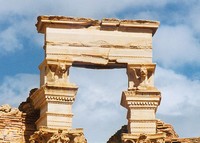
Photo Galen R. Frysinger"]
Text[140]=["Demre (anc. Myra) ","Greco-roman theatre destroyed in 141 by a seism, but rebuilt shortly after. Good state of conservation."]
Text[141]=["Tadmor (anc. Palmyra)","The ruins extend on 50 hectares. The greco-roman temple of Ba’al (Bel), 1st century. The Decumanus and its colonnades, Septime Severe’s arch ; Diocletian baths, baths of Zenobia. Beautiful theatre (1st century). The tetrapylon (groups of 4 columns placed at the corners of a rectangular base, marking the center of the city). Necropolis and impressive monuments.
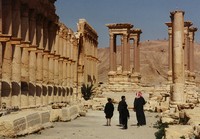
Photo Galen R. Frysinger"]
Text[142]=["Alexandria","Roman baths, odeon of Kom-el-Dick, catacombs of Kom-el-Chouqafa, Diocletian’s column.
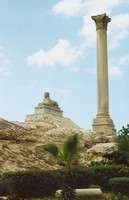
Photo Galen R. Frysinger"]
Text[143]=["Baalbek","Impressive ruins of the ancient greek-roman Heliopolis, with more ancient remains from semitic times. Temple of Jupiter, temple of Bacchus, temple of Venus (site listed by UNESCO).
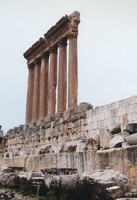
Photo Galen R. Frysinger"]
Text[144]=["Salamis","Important antique site, the ruins are from the roman period. Gymnasium, baths, theatre, amphitheatre, temple of Zeus. "]
Text[145]=["Nora","Pre-Roman and Roman city located on the peninsula of Pula in Sardinia. Roman ruins, beautiful mosaics, temples, villas, cobbled streets, the baths and the theatre.
 "]
applyCssFilter()
"]
applyCssFilter()
























 "]
Text[122]=["Kourion","Mosaics in the houses of Achilles, of the Gladiators, of Eustolios. The theatre, the baths. Stadium of the 2nd century AD. Sanctuary of Apollo.
"]
Text[122]=["Kourion","Mosaics in the houses of Achilles, of the Gladiators, of Eustolios. The theatre, the baths. Stadium of the 2nd century AD. Sanctuary of Apollo. "]
Text[123]=["Adana ","The roman 310m long stone bridge which crosses the river Seyhan (anc. Sarus) at Adana, kept 14 of its 21 original arches. The date of construction remains uncertain… "]
Text[124]=["Cesarea (anc. Caesarea Maritima)","Herodian theatre, aqueduct (335 m), ruins of the baths and of habitations"]
Text [125] = [" Beit Guvrin (anc. Eleutheropolis) " , " Ruins of the amphitheatre"]
Text[126]=["Sour (anc. Tyr) ","Necropolis, aqueduct, monumental arch, roman road, hippodrome, ruins of the baths, amphitheatre.
"]
Text[123]=["Adana ","The roman 310m long stone bridge which crosses the river Seyhan (anc. Sarus) at Adana, kept 14 of its 21 original arches. The date of construction remains uncertain… "]
Text[124]=["Cesarea (anc. Caesarea Maritima)","Herodian theatre, aqueduct (335 m), ruins of the baths and of habitations"]
Text [125] = [" Beit Guvrin (anc. Eleutheropolis) " , " Ruins of the amphitheatre"]
Text[126]=["Sour (anc. Tyr) ","Necropolis, aqueduct, monumental arch, roman road, hippodrome, ruins of the baths, amphitheatre.






 "]
applyCssFilter()
"]
applyCssFilter()